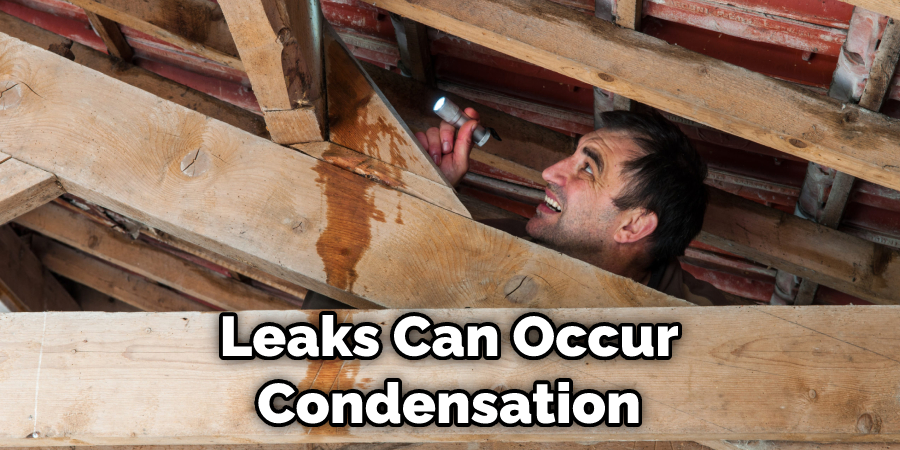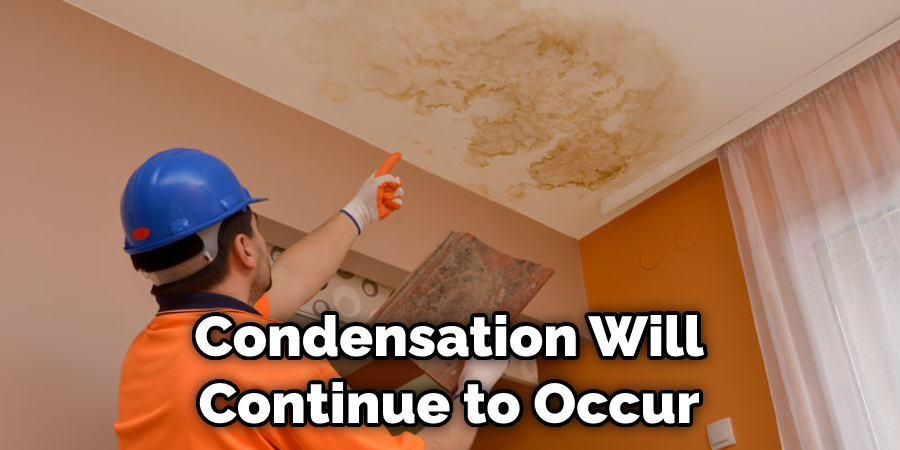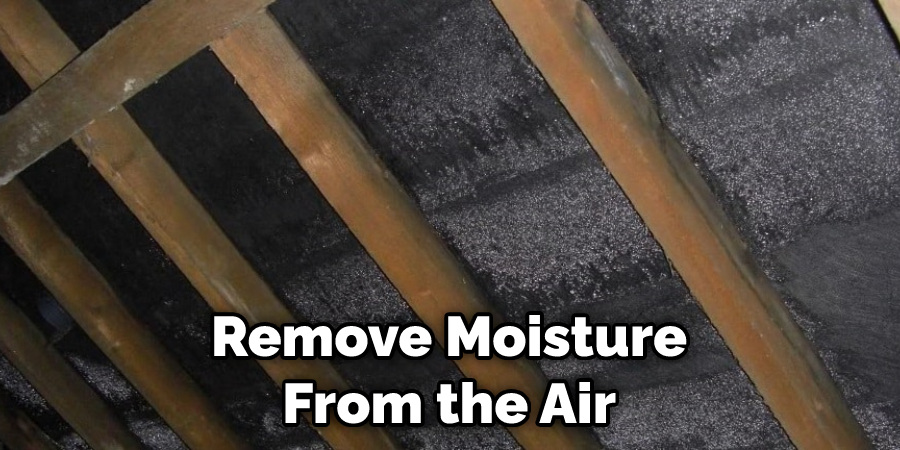Roof condensation occurs when warm, moist air meets a cold surface. This can happen in any season but is most common in winter when there is a significant temperature difference between the inside and outside of your home.

Are you experiencing a problem with roof condensation? If so, don’t worry – you’re not alone. This is a common issue that many homeowners face, but it can be easily fixed. This blog post will explore some of the causes of roof condensation and how to fix roof condensation. We’ll also provide some helpful tips for preventing roof condensation in the future. Read on to learn more.
Summary: Stop roof condensation with a few easy steps. Insulate your attic, improve attic ventilation, use a dehumidifier, seal any air leaks, install a vapor barrier, use a fan to circulate air and an air purifier for extra protection. Additionally, keep your gutters clean, repair any damaged roof shingles, and consider hiring a professional if needed.
What Causes Roof Condensation?
There are a few different things that can cause roof condensation. These include:
Temperature Difference
As we mentioned, the biggest cause of roof condensation is a temperature difference. When it’s warm inside your home and cold outside, the warm air will rise and meet the cold surface of your roof. This can happen in any season but is most common in winter.
Poor Ventilation
Another common cause of roof condensation is poor ventilation. If your home doesn’t have enough ventilation, the warm, moist air will have nowhere to go and will eventually meet the cold surface of your roof. This can lead to condensation, mold, and mildew.
Leaks
Leaks can also cause roof condensation. If there is a leak in your roof, the warm, moist air will escape through the hole and meet the cold surface of your roof. This can cause condensation, mold, and mildew.

High Humidity
High humidity can also cause roof condensation. If the air in your home is too humid, it will eventually meet the cold surface of your roof, and condensation will occur. Humidity is often caused by things like cooking, showering, and laundry.
Poor Insulation
Poor insulation can also cause roof condensation. If your home is not properly insulated, the warm air will escape and meet the cold surface of your roof. This can cause condensation to form on your roof and eventually lead to leaks.
Things to Consider Before You Start
Before trying to fix roof condensation, you should keep a few things in mind. These include:
The Type of Condensation You Have
There are two main types of condensation – surface condensation and bulk condensation. Surface condensation is when the water droplets form on the surface of your roof. Bulk condensation is when the water droplets form inside your insulation.
The Cause of the Condensation
As we mentioned, there are a few different things that can cause roof condensation. Therefore, it’s important to identify the condensation’s cause before trying to fix it. Otherwise, you may not be able to fix the problem completely.
The Location of the Condensation
Condensation can occur in any part of your home, but it’s most common in the attic. If you have condensation in your attic, it’s important to ventilate the area properly. Otherwise, the condensation will continue to occur.

The severity of the Condensation
The severity of the condensation will also play a role in how you fix the problem. If the condensation is minor, you may be able to fix it yourself. However, if the condensation is severe, you may need to hire a professional.
A Complete Guide on How to Fix Roof Condensation
1. Insulate Your Attic
Your attic is the first place to start when you’re trying to reduce roof condensation. Ensuring that your attic is properly insulated prevents heat from rising and escaping through the roof. This will help to keep your home warmer overall, which will, in turn, prevent condensation from forming on your roof. Of course, you’ll need to add insulation to your attic floor and walls to do this. This can be done with fiberglass batt insulation, blown-in cellulose, or spray foam.
2. Improve Attic Ventilation
In addition to insulating your attic, you’ll also need to ensure it’s well-ventilated. Attic ventilation helps regulate the temperature and humidity levels in your attic, which can help prevent condensation from forming. There are a few different ways that you can improve attic ventilation, such as:
- Installing a ridge vent:
- This type of vent runs along the length of your roof ridge. It helps draw air out of your attic, which can help keep the space cooler and drier.
- Adding soffit vents:
- These vents are installed in the soffits of your attic (the underside of the eaves). They help draw air into your attic, which can help to regulate the temperature and reduce condensation.
- Adding gable vents:
- Gable vents are installed in the gables of your attic (the triangular area at the end of your roof). They help draw air out of your attic, which can help keep the space cooler and drier.
3. Use a Dehumidifier
Another way to reduce roof condensation is to use a dehumidifier in your attic. Dehumidifiers help remove moisture from the air, which can help to keep your attic drier and prevent condensation from forming. If you live in a humid climate, you may need to use a dehumidifier year-round to keep your attic dry.

4. Seal Air Leaks
One of the main causes of roof condensation is air leaks. When there are gaps or cracks in your attic, warm air can escape from your home and cause condensation to form on your roof. To prevent this, you’ll need to seal any air leaks in your attic. You can do this with caulk, weatherstripping, or expanding spray foam. If you’re unsure where the air leaks are, you can have an energy audit to identify them.
5. Install a Vapor Barrier
Another way to prevent condensation is to install a vapor barrier in your attic. A vapor barrier is a material that helps to prevent moisture from passing through it. This can help to keep your attic drier and prevent condensation from forming. Vapor barriers are usually made of plastic or foil and can be installed on the floor, walls, or ceiling of your attic.
6. Use a Fan to Circulate Air
Another way to prevent condensation is to use a fan to circulate air in your attic. By circulating air, you can help to keep the space drier and prevent condensation from forming. Attic fans are usually installed in your attic’s gables and help draw air out of the space. This can help to keep the space cooler and reduce condensation.
7. Use an Air Purifier
An air purifier can also help to reduce condensation in your attic. By removing contaminants from the air, an air purifier can help to keep your attic cleaner and drier. This can, in turn, prevent condensation from forming. Air purifiers can be used in conjunction with other methods, such as attic ventilation, to further improve the air quality in your attic.
8. Keep Your Gutters Clean
One of the main causes of roof condensation is clogged gutters. When your gutters are clogged, water can back onto your roof and cause condensation. To prevent this, you’ll need to keep your gutters clean and debris-free. You can do this by regularly cleaning them out with a garden hose or by having a professional gutter cleaning service do it for you. If you live in an area with many trees, you may need to have your gutters cleaned more often.
9. Repair Any Damaged Roof Shingles

Another common cause of roof condensation is damaged roof shingles. When your shingles are cracked, curling, or missing, they can allow water to seep into your attic and cause condensation to form. To repair damaged shingles, you’ll need to replace the damaged ones with new ones. If your shingles are curling, you can also use a roofing sealant to help hold them down.
10. Hire a Professional
If you’re uncomfortable doing any of the above yourself, you can always hire a professional to help you with your roof condensation problem. An experienced roofer will be able to identify the cause of your condensation and recommend the best course of action. They can also help to repair any damage that has already been done. If you’re unsure whether you need a professional, you can always contact a roofing contractor for an evaluation.
You Can Check It Out To Fix a Leaking Tile Roof
How Much Does It Cost To Fix Roof Condensation?
The cost to fix roof condensation can vary depending on the problem’s cause and extent. However, most homeowners will spend between $200 and $1,000 to fix the problem. Cost factors include the type of repair needed, the size of your attic, and whether or not you hire a professional.
Frequently Asked Questions
Why Is There so Much Condensation on My Roof?
When the temperature rises above 68 degrees Fahrenheit, water vapor becomes saturated in the atmosphere and forms droplets. This phenomenon is most commonly seen during summertime when there are high humidity levels.
Another potential cause of condensation on roofs may be rain gutters or downspouts that aren’t draining properly. When heavy rainfall hits these areas, it causes runoff which leads to flooding inside homes or business establishments. Finally, wind can also create atmospheric conditions that lead to precipitation accumulation on roofs.
Is It Normal to Have Condensation on the inside of a Roof?
Yes, it is very common for roofs to have condensation on the inside. This happens because of thermal bridging, which is a phenomenon in which heat leaves one object and enters another object at a lower temperature due to an air barrier or physical contact. In most cases, this results in water droplets forming on surfaces that are in close proximity to each other.
The best way to prevent roof condensation is by keeping your home warm and dry during the winter months. Make sure you use energy-efficient appliances and windows that let sunlight into your home freely without allowing drafts through. Additionally, make sure there’s adequate insulation around your anticlines and walls so that heat can’t escape from the house easily.
Does Roof Insulation Stop Condensation?
Yes, roof insulation can help to stop condensation from occurring. In fact, it can help to reduce the amount of moisture that accumulates on the roofing system, which can eventually lead to leaks and rot. In addition, roof insulation can help to keep the building cooler in summer and warmer in winter, which is a valuable asset in terms of energy conservation.
Should I Run a Dehumidifier in My Attic?
If you are in the market for an effective dehumidifier, then it is important to consider your needs and preferences. Some factors that you may want to take into account include the size of your attic, how often you experience moisture problems, and whether or not running a dehumidifier will cause any damage.
When looking at brands and models, be sure to read customer reviews before making a decision. It can also be helpful to consult with an experienced home improvement professional about which unit is best for your specific situation. Ultimately, if you have frequent moisture problems or suspect that there is water inside the walls of your attic or crawlspace, then a dehumidifier may be a good investment for you.
Conclusion
This article provides an overview of roof condensation and how to fix roof condensation. When fixing roof condensation, remember the following things. Ensure your insulation is up to par, that you have proper ventilation, and use an airtight sealant on all your roofing materials. If you follow these tips, you can keep your home warm in the winter and cool in the summer while preventing any roof condensation from occurring.
You Can Check It Out To Fix a Cracked Roof Tile
